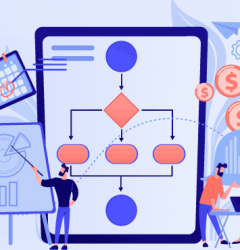
This article was first published on CustomerThink
Automation transforms businesses by streamlining processes, improving efficiency, and reducing costs. As technology advances, there is a growing trend toward the democratization of automation. This article will explore four key drivers impacting this democratization process: democratized development, the rise of digital nomads, empowered employees, and the gig economy, the emergence of the automation fabric, and the proliferation of mining and process discovery tools.
Four Key Drivers of Democratization of Automation
1. The Advent of Democratized Development
The democratization of development is the process by which more people gain access to the tools and skills required to create and utilize automated systems. One of the primary drivers of the democratization of automation is the increasing accessibility of development tools and platforms. Previously, automation solutions were reserved for large corporations with significant resources. However, the rise of low-code and no-code media, open-source libraries, and software development kits (SDKs) has leveled the playing field, enabling small businesses and even individuals to develop their automation solutions.
According to a Gartner report, by 2024, low-code/no-code application development will represent more than 65% of application development activity. This increased accessibility has spurred innovation, with businesses and individuals finding new ways to leverage automation, streamline processes, and reduce costs.
a. Open-source software
The availability of open-source tools and libraries has made it easier for individuals and organizations to develop automation solutions without investing in proprietary software.
b. Low-code/no-code platforms
Also called the Rapid Application Development platforms users with little programming knowledge to create and implement automated solutions. This has made it easier for businesses to adopt automation in their operations.
c. Online learning resources
The growth of online learning platforms, like Coursera and Udacity, has made it easier for individuals to acquire the necessary skills to develop automation solutions.
2. The Rise of Digital Nomads, Empowered Employees, and the Gig Economy
Digital transformation has enabled employees to work remotely and collaborate more effectively, regardless of location. It has led to the emergence of digital nomads and the gig economy, where workers are no longer tied to a single employer or location. As per the study by MBO Partners, the number of digital nomads in the United States alone grew to 10.9 million, an increase of 49% compared to 2019.
The rise of digital nomads and the gig economy has contributed to the democratization of automation by creating a more adaptable, flexible workforce open to new technologies. These individuals can leverage automation tools to increase productivity, manage tasks, and communicate more efficiently. As a result, businesses and employees alike are better positioned to adapt to the ever-evolving technological landscape.
a. Digital Nomads
Digital nomads leverage technology to work remotely, often from different countries, and embrace a location-independent lifestyle. Affordable automation tools, such as project management software and AI-driven virtual assistants, have enabled digital nomads to manage their work efficiently and productively.
b. Empowered Employees
As automation tools become more accessible and user-friendly, employees are empowered to incorporate them into their daily workflows. This promotes a culture of innovation, where employees can continuously optimize their tasks and contribute to the overall success of their organizations.
c. Gig Economy
The gig economy consists of temporary, flexible jobs where workers act as independent contractors. Automation has enabled these gig workers to manage multiple projects simultaneously, streamline their workflows, and optimize their earnings.
Also Read: A Comprehensive Glossary of Digital Transformation Terms
3. The Emergence of the Automation Fabric
The automation fabric refers to integrating various technologies into a cohesive, interconnected system. This concept goes beyond just integrating disparate tools and platforms; it involves creating an ecosystem where automation solutions can communicate and collaborate, ultimately driving greater efficiency and effectiveness.
With the emergence of the automation fabric, organizations can now tap into an extensive array of automation tools, from robotic process automation (RPA) to artificial intelligence (AI) and machine learning (ML). According to Forrester, the global market for RPA alone is expected to reach $12 billion by 2023. The growing prevalence of these technologies enables businesses to develop more sophisticated and comprehensive automation solutions, further democratizing the potential applications of automation.
a. Comprehensive Approach to Automation
The automation fabric connects disparate automation tools and technologies, creating a unified and holistic approach to process automation. This comprehensive approach enables organizations of all sizes to leverage the power of automation without a massive investment in infrastructure or specialized expertise.
b. Scalability and Flexibility
Organizations can scale their automation initiatives according to their needs and resources as the automation fabric provides a modular and adaptable framework. This flexibility allows businesses to adopt automation at their own pace, promoting a more democratic and inclusive approach to automation.
c. Enhanced Collaboration and Efficiency
The automation fabric facilitates collaboration between different departments and teams, breaking down silos and fostering a more efficient and effective work environment. By integrating various automation technologies, the automation fabric streamlines workflows, reduces manual intervention, and accelerates delivery of digital transformation initiatives.
4. The Proliferation of Mining and Process Discovery Tools
Process mining and discovery tools are essential components in the democratization of automation. These technologies enable businesses to gain insights into their processes, identify inefficiencies, and implement targeted automation solutions. According to Grand View Research, the global process analytics market, which includes process mining and discovery, is expected to have a CAGR of 49.6% from 2021 to 2028.
Vendors focus on making their process optimization tools more straightforward and accessible to business users. In addition, mining tools have matured, and process and task
mining provide objective and automated insights into operations. Process modeling and documentation tools enable collaboration and consensus, thus becoming part of a continuous process improvement cycle.
These tools increasing availability and sophistication allow organizations of all sizes to enhance their operations and implement automation more effectively. By providing a deeper understanding of existing processes, mining and process discovery tools pave the way for more informed decision-making and strategic planning.
Also Read: A Complete Guide to Workflow Automation Software
Conclusion
In conclusion, the democratization of automation is reshaping the business landscape, driven by four key factors: democratized development, the rise of digital nomads and the gig economy, the emergence of the automation fabric, and the proliferation of mining and process discovery tools. The increasing accessibility of development tools, the rise of remote work, and the gig economy have fostered a culture of innovation and adaptability. The automation fabric and process discovery tools enable businesses to develop comprehensive, flexible automation solutions, enhancing collaboration and efficiency across teams. As automation continues democratizing, enterprises of all sizes benefit from these technologies’ transformative power, resulting in increased productivity, reduced costs, and improved overall performance.
Login
Please login to comment
0 Comments
Oldest















